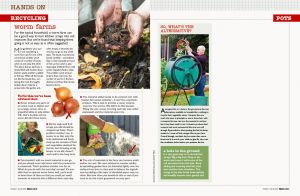For the typical household, a worm farm can be a good way to turn kitchen scraps into soil improver. But we’ve found that keeping them going is not as easy as is often suggested.
Most gardeners who own or are considering a worm farm opt for one of the commercial varieties which consist of a number of boxes which sit one atop the other. The idea is that as each box is slowly filled with broken-down kitchen waste another is added to the top. When all the boxes are full, the lowest box, containing the most thoroughly broken-down material, is spread onto the garden and, when empty, it becomes the next box to go on top of the stack. The boxes must be positioned carefully – somewhere that is never exposed to hours of hot sun but which is also reasonably sheltered from cold winds. Dappled shade is ideal.
The problem we’ve encountered is that, over time, the number of worms in the farm declines and those that remain become skinny.
To fix this we’ve been advised that:
• Never include any parts of an onion, leek or shallot and no orange, lemon, lime or grapefruit skins or pulp either. OK, that’s do-able and we never did add those items.
• All the vegie and fruit scraps you add should be chopped up finely. That’s problem number one. It seems to us that only the truly dedicated will finely chop up the remains of fruit and vegetables destined for the bin, but throwing in big lumps, as we did, doesn‘t work well in the long term.
• You shouldn’t add too much material in one go and you should never add more until the previous lot is consumed. That’s problem number two for us. What do you do with the next day’s scraps? It’s possible that to operate worm farms well, you’d need to have three of them so that you could put small amounts of material into a different farm each day.
• The material added needs to be covered over with hessian felt carpet underlay – it can‘t be a synthetic product. This is said to provide a cosier environment for the worms. We didn’t do this because lifting the wet, messy covering each day was rather unpleasant and the material soon rots.
• The mix of materials in the farm can become acidic and/or too wet. We were advised to counter acidity by sprinkling garden lime (or dolomite) lightly over the surface from time to time and to balance the ingredients by adding a thin layer of shredded paper every so often. But how often you should do this or even if you need to do this is just guesswork on your part.
So, what‘s the alternative?
A compost bin or a hole in the ground are the two alternatives available to householders wishing to recycle their vegetable waste.
Compost bins are much the same in principle as worm farms but, with a compost bin you can toss the material in and just let it stay there until it rots. It doesn’t produce ideal compost and most commercial bins are not well enough fly-proofed so that opening the bin lid always results in a mass of little vinegar flies in your face. Overall though, we think they‘re easier than worm farms and it is worth your while to glue fly wire over the ventilation holes before you position the bin.
A hole in the ground is a very good way to re-use kitchen scraps. Dig a big hole. Drop in the waste and cover it with some of the soil excavated from the hole. Keep adding and covering until full, then start another hole elsewhere. The scraps in the hole break down quickly and steadily improve your garden soil.
The original article was published in the March 2010 issue of Burke’s Backyard magazine. Text by Geoffrey Burnie, photos by Brent Wilson.



